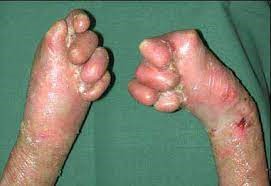Epidermolysis bullosa
5. Musculokeletal deformities
The musculoskeletal system deformities are a frequent problem in people with severe types of EB and, apart from causing a functional limitation, they are also the origin of many psychological problems.
The most important visible musculoskeletal complication of EB is pseudodactyly, commonly known as the “claw or mitten hand/foot”. This injury is especially frequent in the generalized dystrophic type, and it is produced due to the repetitive presence of blisters between the fingers or toes which favours the synechiae (merging) of the interdigital areas of one or more fingers. In more severe forms all the extremities’ fingers/toes can be united limiting the hand movement and its functioning in big measure. If the pseudodactyly is not corrected early through surgery, the muscles left unused can end up atrophying.
